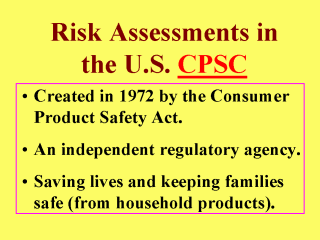| front |1 |2 |3 |4 |5 |6 |7 |8 |9 |10 |11 |12 |13 |14 |15 |16 |17 |18 |19 |20 |21 |22 |23 |24 |25 |review |
 |
The U.S.
Consumer Product Safety Commission (CPSC) is an independent regulatory agency created in
1972 by the Consumer Product Safety Act. Like that of FDA (Slide 17), CPSC’s mission is
also for consumer protection but with a specific goal of keeping American families safe by
preventing or reducing the risk of injury, illness, or death from primarily household
consumer products. Some of the more recent consumer products over which CPSC has a
concern, that leading to recall, include a gas grill, a pacifier clip, and a juice
extractor. It also offers safe tips for sleeping babies. Empowered by the older Federal Hazardous Substances Act (FHSA), CPSC regulates consumer products that generate pressure or that are combustible, toxic, corrosive, or radioactive. Its means of product regulation is primarily through label warnings. In terms of health risk assessment (RA) activities, CPSC apparently has been less active in federal efforts to regulate toxic chemicals, in part due to its small size and limited operating budget. However, partly because of the unique provisions contained in FHSA, CPSC is among the forefronts in providing criteria for toxicity tests, primarily those on acute toxicity in animals, such as the primary irritation assay in rabbits. CPSC obtains most of its RA data from other sources, including EPA (Slide 19) and FDA. |